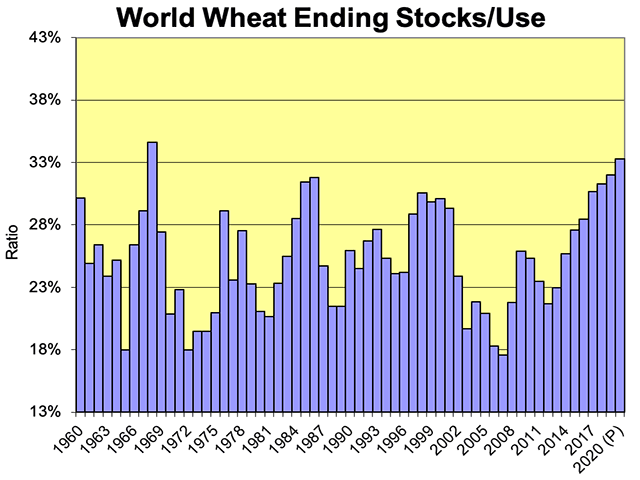Wheat Wins WASDE
The Surprise Winner of WASDE Is Wheat
Commodity traders were active buyers of corn, soybeans and wheat Wednesday and Thursday, placing their bets ahead of the December World Agricultural Supply and Demand Estimates (WASDE) supply and demand report. While they were also buying gold, crude oil and some other items, they were clearly focused on the "event risk" of the USDA report and anticipating a bullish outcome for the three crops.
Wheat turns out to have been the best bullish bet on USDA report day. It had been expected to be the quiet one, with little change in U.S. ending stocks and a possible increase in the already record-large global ending stocks figure.
What happened?
The U.S. wheat markets had been selling off over the last couple weeks, trying to become more competitive versus cheaper FOB offers from France, Russia, among others; USDA projected record large world wheat ending stocks in the November WASDE report, and USDA was also expected to increase production forecasts for Australia, Canada and possibly Russia in December.
The 3.95 million-metric-ton (mmt) cut in projected world wheat ending stocks was the biggest surprise in the report, both in the size of the cut and because traders had been leaning toward an increase. It wasn't a revision issue, as beginning stocks were lowered only 140,000 metric tons (mt). Production was increased in the expected places but not always by the expected amounts. Australia was hiked 1.5 mmt to 30 mmt despite ABARES raising their estimate to 31.17 mmt. Briefing notes show some concern about wet weather interfering with harvest in some states. Russian production was increased another 500,000 mt to 84 mmt.
Despite a strong export program, Russian ending stocks are expected to be at a multiyear high of 10.73 mmt. Food prices are soaring in Russia, raising questions about future export limits. Canadian production was hiked 180,000 mt based on Stats Canada data. The big shift in the report was a 3.9 mmt hike in projected wheat feeding globally versus last month. Of that, 3 mmt was expected to happen in China, where corn futures prices are approaching $10 per bushel and wheat works into feed rations.
World wheat ending stocks are still expected to be record large on May 31, at 316.5 mmt. They would be second highest on record as a percent of use, trailing only 1986 at 31.8% (marked with an * in the table).
| Mkt year 1/ | Prod'n | Feed use | Dom Disapp | Exports | Ending stocks | Stx/Use% | USDA Av $ |
| (MMT) | |||||||
| 1986 | 524.082 | 113.192 | 511.348 | 89.274 | 191.05 | *31.8% | 2.42 |
| 1987 | 497.881 | 113.646 | 530.286 | 111.565 | 158.645 | 24.7% | 2.57 |
| 1988 | 495.018 | 103.981 | 519.638 | 105.151 | 134.025 | 21.5% | 3.72 |
| 1989 | 533.152 | 103.668 | 531.011 | 103.419 | 136.166 | 21.5% | 3.72 |
| 1990 | 588.046 | 130.089 | 553.676 | 103.843 | 170.536 | 25.9% | 2.61 |
| 1991 | 542.904 | 113.82 | 551.47 | 109.948 | 161.97 | 24.5% | 3 |
| 1992 | 561.646 | 110.918 | 547.617 | 110.039 | 175.699 | 26.7% | 3.24 |
| 1993 | 558.035 | 107.971 | 552.371 | 103.717 | 181.363 | 27.6% | 3.26 |
| 1994 | 523.188 | 99.559 | 542.419 | 98.215 | 162.132 | 25.3% | 3.45 |
| 1995 | 537.927 | 91.922 | 544.785 | 99.195 | 155.274 | 24.1% | 4.55 |
| 1996 | 582.609 | 96.652 | 573.429 | 106.903 | 164.454 | 24.2% | 4.3 |
| 1997 | 609.959 | 100.948 | 577.457 | 104.413 | 196.956 | 28.9% | 3.38 |
| 1998 | 589.96 | 103.649 | 579.066 | 101.284 | 207.85 | 30.6% | 2.65 |
| 1999 | 585.817 | 98.923 | 585.141 | 113.449 | 208.526 | 29.8% | 2.48 |
| 2000 | 582.787 | 109.846 | 583.957 | 101.195 | 206.051 | 30.1% | 2.62 |
| 2001 | 583.871 | 111.942 | 587.076 | 105.783 | 203.297 | 29.3% | 2.78 |
| 2002 | 569.667 | 116.141 | 602.226 | 105.341 | 169.109 | 23.9% | 3.56 |
| 2003 | 555.689 | 101.68 | 581.474 | 108.519 | 135.912 | 19.7% | 3.4 |
| 2004 | 626.747 | 110.715 | 605.591 | 111.081 | 156.427 | 21.8% | 3.4 |
| 2005 | 618.828 | 117.699 | 616.153 | 117.394 | 153.28 | 20.9% | 3.42 |
| 2006 | 596.688 | 113.084 | 618.852 | 111.559 | 133.491 | 18.3% | 4.26 |
| 2007 | 612.228 | 105.024 | 614.35 | 116.39 | 128.475 | 17.6% | 6.48 |
| 2008 | 684.784 | 123.963 | 636.779 | 144.121 | 170.062 | 21.8% | 6.78 |
| 2009 | 688.18 | 123.295 | 651.005 | 136.764 | 204.078 | 25.9% | 4.87 |
| 2010 | 650.662 | 117.745 | 654.537 | 133.04 | 199.308 | 25.3% | 5.7 |
| 2011 | 698.682 | 149.753 | 691.209 | 157.644 | 199.495 | 23.5% | 7.24 |
| 2012 | 660.373 | 139.429 | 688.089 | 138.069 | 179.022 | 21.7% | 7.77 |
| 2013 | 716.518 | 127.262 | 691.08 | 165.926 | 196.998 | 23.0% | 6.87 |
| 2014 | 730.375 | 132.334 | 700.367 | 164.229 | 222.247 | 25.7% | 5.99 |
| 2015 | 738.415 | 141.712 | 713.685 | 172.787 | 244.355 | 27.6% | 4.89 |
| 2016 | 756.4 | 147.04 | 739.09 | 183.36 | 262.31 | 28.4% | 4.89 |
| 2017 | 762.88 | 146.63 | 741.98 | 182.47 | 283.69 | 30.7% | 4.89 |
| 2018 | 730.9 | 139.2 | 734.75 | 173.67 | 284.11 | 31.3% | 4.89 |
| 2019 | 764.5 | 139.16 | 747.98 | 191.46 | 300.62 | 32.0% | 3.89 |
| 2020 | 773.66 | 141.03 | 757.78 | 193.65 | 316.5 | *33.3% | 4.65 |
So why are Chicago wheat futures prices being supported above $5.90 per bushel and KC hard red winter (HRW) wheat above $5.60, when we're looking at a near-record global surplus? Here are two points to consider: Tightening U.S. stocks and a lack of access to the mammoth Chinese stocks.
USDA made a larger change to the U.S. wheat ending stocks than the trade had expected. Imports were cut 5 million bushels (mb) due to the slow pace of incoming bushels. Exports were increased 10 million bushels on stronger white wheat demand. Expected HRW exports were reduced.
U.S. wheat stocks are shrinking: As this small table illustrates, the current forecast for 862 mb would be the smallest May 31 figure since 2015. The stocks-to-use ratio is loosely correlated to average prices and is also the tightest since 2014-15. We say loosely correlated because USDA is combining cash prices for five different classes of wheat in one number and also weighing those prices by the percentage of the crop marketed each month. Timing of the high within the marketing year can substantially influence the average price received.
| Year | 2014/15 | 2015/16 | 2016/17 | 2017/18 | 2018/19 | 2019/20 | 2020/21 |
| End Stx | 752 | 976 | 1181 | 1099 | 1080 | 1028 | 862 |
| Stx/Use % | 37.3% | 50.0% | 53.2% | 55.5% | 53.0% | 49.2% | 40.8% |
| Avg Cash | $5.99 | $4.89 | $3.89 | $4.72 | $5.16 | $4.58 | $4.70 |
Finally, keep in mind that China holds 51% of the projected global wheat ending stocks and that wheat is generally not available to the export market. Estimated wheat stocks outside of China (including those tightening U.S. stocks) would only be 155 mmt, a much "snugger" 20.6% of consumption after deducting Chinese use from the world number.
None of the above requires wheat to rally much from here, but the combination of an oversold market coming into this week and the tightening numbers above help explain why wheat bulls were the big winners on report day in the grain complex.
Alan Brugler may be reached at alanb@bruglermktg.com
(c) Copyright 2020 DTN, LLC. All rights reserved.
P[L1] D[0x0] M[300x250] OOP[F] ADUNIT[] T[]




